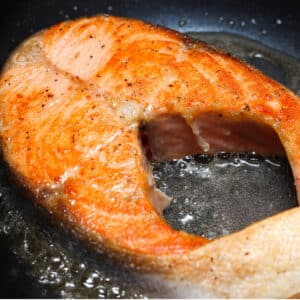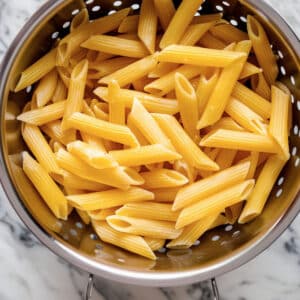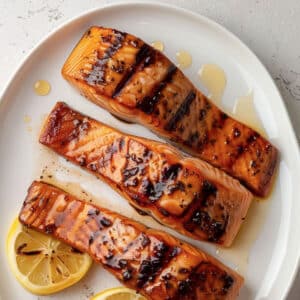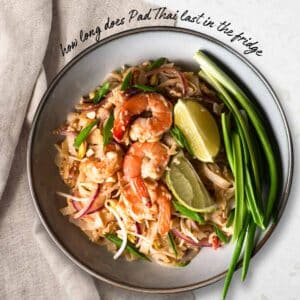Do you love taro milk tea? If you do, you're probably wondering if it has caffeine. After all, if you're like me, you want to know if drinking your favorite drink will keep you up at night! And if you're looking for an energizing drink that doesn't come with the jitters, taro milk tea may be a good option.
So does taro milk tea have caffeine?
Spoiler alert: there's not a lot of caffeine in taro milk tea, so it's a great choice if you're looking for a low-caffeine beverage! It all depends on what kind of tea is used to make taro milk tea. But there will be more caffeine with black or oolong tea than with green tea.
Taro milk tea generally has less caffeine than coffee, so it's a good choice if you're looking for an energy boost without the jitters! And if you want to enjoy a cup of taro milk tea before bed, don't worry - you'll probably be able to sleep just fine. So go ahead and enjoy your favorite drink without worry!
Jump to:
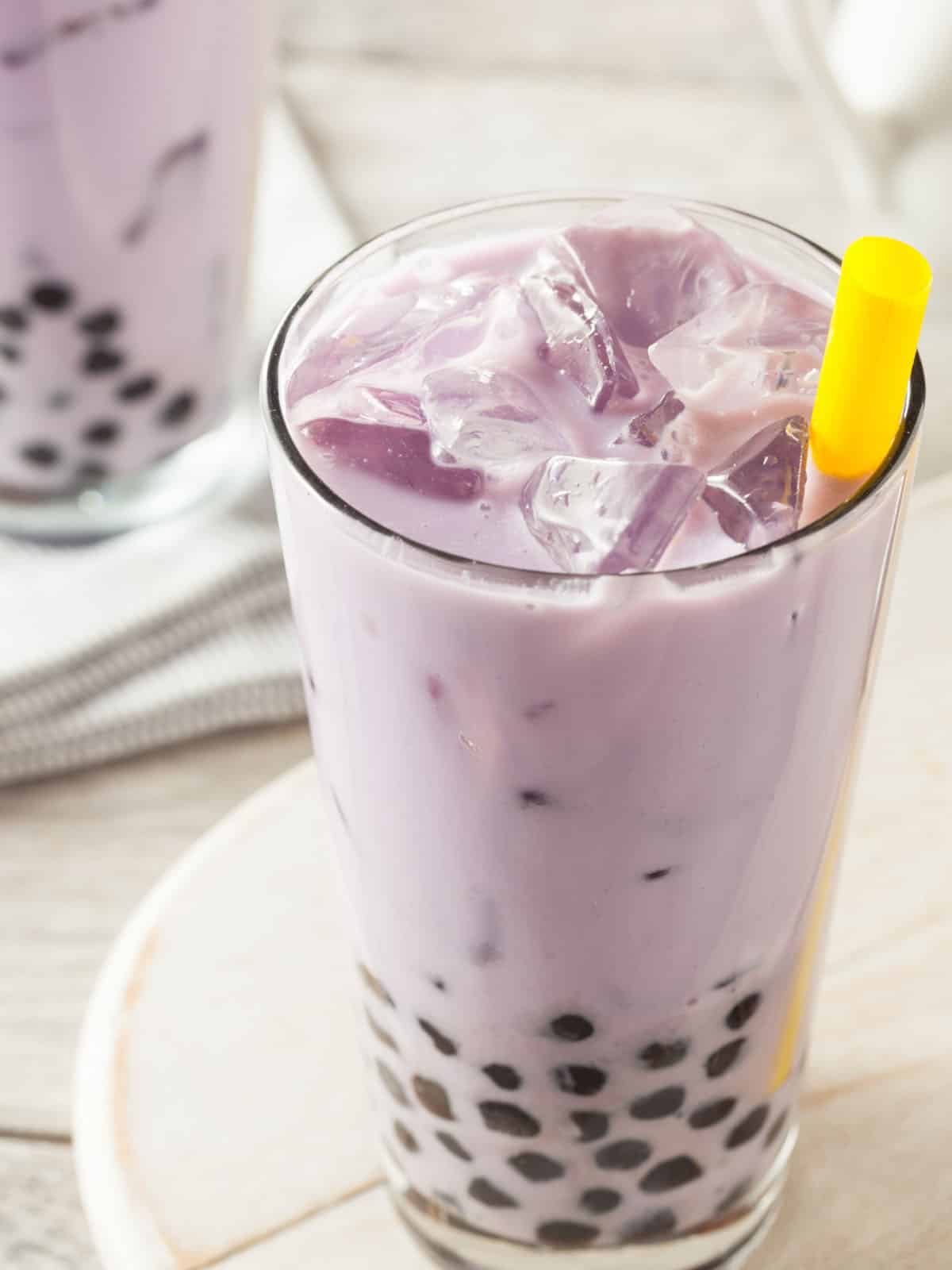
In this post, I'll let you know how much caffeine is in taro milk tea and whether or not it's a good choice if you're trying to cut back on your coffee intake. Keep reading to find out more.
What is taro milk tea made of?
Knowing the ingredients for the taro milk tea will give us an idea of how much caffeine is present in each serving. I posted the recipe for making Taro Milk tea with boba pearls (bubble tea) a while back. You can check my post for more detailed step-by-step instructions and photos.
Ingredients:
For Tea:
- 1 cup Taro (sliced ½" cubes)
- 8 oz Okinawan purple sweet potato (or 1 cup)
- 2 tablespoon Jasmine tea (loose leaves)
- 4 cups water
Boba Assembly:
- 1 cup tea mixture (from the above ingredients)
- 2 tablespoon condensed milk
- ⅓ cup milk (I used evaporated milk)
- ½ teaspoon Ube extract (depends on how deep the color you want)
- 2 scoops Ube flavor ice cream (optional)
Garnish:
- ½ cup Tapioca pearls
- 1 tablespoon Dehydrated Ube or Taro powder (optional)
- frothed milk (or whipping cream)
Does taro milk tea have caffeine?
The answer is YES; there is caffeine in taro milk tea because it contains tea leaves (black, green, oolong, white, or pu-erh), which all come from the Camellia sinensis plant. The amount of caffeine in taro milk tea will depend on how strong you make the tea and how much tea you use.
The average cup (237 ml) of black tea contains 47 milligrams of caffeine, while a cup of green tea has just 26 milligrams. Steeping for a shorter time will produce a cup of tea with less caffeine. Milk or cream added to either kind of tea will lower the caffeine content by about 10 percent. On the other hand, an herbal brew made with taro leaves contains no caffeine. (source, source)
Taro root itself contains deficient levels of caffeine. Therefore, this recipe for taro milk tea has a moderate amount of caffeine overall. If you want to reduce the caffeine content further, you can steep the tea leaves for a shorter time or use decaffeinated tea leaves. In the above recipe, I used Jasmine tea which contains about 30mg of caffeine per cup.
To make an utterly caffeine-free taro milk tea, you can use herbal teas such as chamomile or lavender instead of traditional tea leaves. Herbal teas do not contain caffeine.
When it comes to tapioca pearls, they come from cassava, which does not contain caffeine. However, some brands may add caffeine to their pearls to flavor or keep them chewy. Therefore, checking the label before purchasing is best to make sure they are caffeine-free.
Overall, taro milk tea contains a moderate amount of caffeine. If you are sensitive to caffeine, you can ask for decaffeinated taro milk tea or make your own at home using herbal teas.
What does the taro milk tea taste like?
Taro milk tea has a smooth and creamy taste with hints of sweet potato. Almost all Asian restaurants serve this tea over ice. Ordering iced or hot can be a little confusing without the experience of taro tea's exotic flavor. Moreover, making it yourself will likely not appeal to those who have not tasted it. So what does taro milk tea taste like?
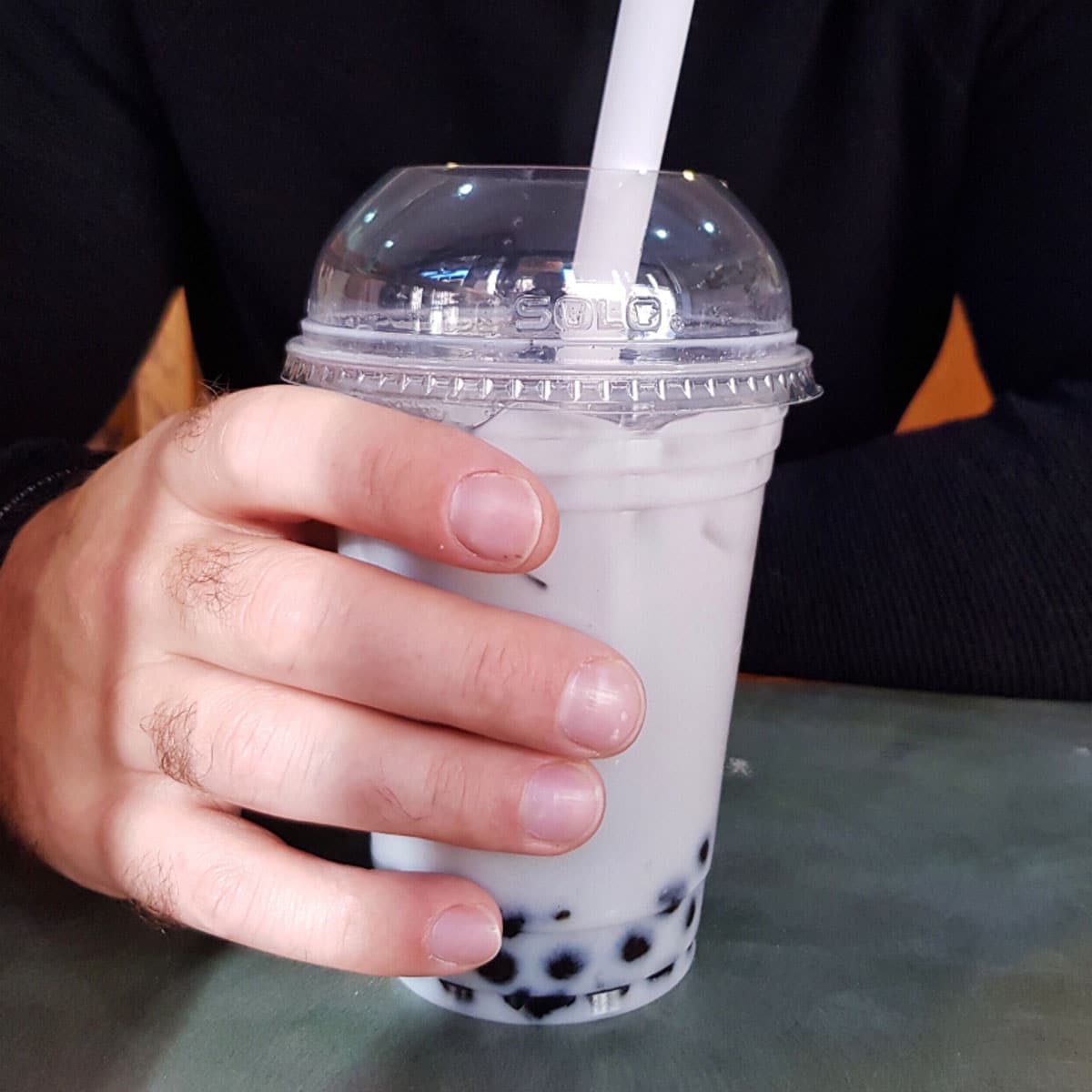
For the uninitiated, taro is a starchy root vegetable similar to sweet potato. When used in teas or desserts, it gives off a slightly nutty and earthy flavor. When mixed with milk and sugar, taro takes on a lovely light purple color and a creamy texture.
The taste of taro milk tea can vary depending on how it is prepared. For example, taro milk tea will have a stronger tea flavor if you use black tea leaves. The taro milk tea will be more mellow if you use green tea leaves. Personally, I prefer using Jasmine tea because it has a delicate floral flavor that goes well with the taro.
If you are sensitive to caffeine, you can ask for decaffeinated taro milk tea at most cafes. In the above recipe, I used Jasmine tea which contains about 30mg of caffeine per cup. The root of taro contains very little caffeine. Therefore, this recipe for taro milk tea has a moderate amount of caffeine overall. If you want to reduce the caffeine content further, you can steep the tea leaves for a shorter time or use decaffeinated tea leaves.
Does taro milk tea come with boba?
Does taro milk tea come with boba when you buy it from a store? Yes, taro milk tea usually comes with boba when you purchase it from a store. However, some stores may sell taro milk tea without boba. If you are looking for a specific type of taro milk tea, you may want to ask the store ahead of time to inquire about their offerings.
How many calories are in taro milk tea?
Taro milk tea generally contains more calories than regular green or black tea. This is because taro milk tea usually has added sugar and other ingredients, such as tapioca balls, which can add to the calorie content. One cup of taro milk tea can range from 200-500 calories.
It is important to note that the calorie content of taro milk tea can vary depending on the ingredients used and the preparation method. For example, if you are ordering taro milk tea from a bubble tea shop, the calorie content may be higher due to the added ingredients. If you make taro milk tea at home, you can control the calorie content by using less sugar or avoiding add-ins like tapioca balls.
What toppings go well with taro milk tea?
A variety of toppings can be added to taro milk tea, depending on your personal preferences. Some typical toppings include:
- Tapioca pearls: also known as boba, these chewy balls are a classic topping for taro milk tea.
- Jelly: typically made from agar agar, jelly is another popular topping for taro milk tea.
- Fruit: fresh or canned fruits such as lychee, mango, or strawberry can add a sweet and refreshing touch to your drink.
- Milk: adding milk to your taro milk tea will give it a creamy texture and flavor.
- Grass jelly: this translucent jelly is made from the stalks of the Mesona Chinensis plant. It has a mild, slightly sweet flavor and a chewy texture.
- Pudding: "pudding" refers to custard made from various ingredients. It is often used as a topping for taro milk tea.
- Bubbles: bubbles, or "QQ," are small, chewy balls made from tapioca starch. They have a slightly sweet flavor and add a fun and unique texture to taro milk tea.
- Egg custard: this smooth and creamy topping is made from eggs, milk, and sugar. Toppings for taro milk tea often contain it.
As you can see, you can add many different toppings to taro milk tea. Try out a few different combinations to find your perfect match! Overall, taro milk tea is a versatile drink that you can customize to your liking.
What is taro milk tea?
Taro milk tea is a refreshing and delicious drink that is perfect for any occasion. Whether you are looking for a quick pick-me-up or a relaxing afternoon beverage, taro milk tea is a great choice. And, with so many different ways to customize it, there is sure to be a taro milk tea recipe that is perfect for you. So, give taro milk tea a try next time you crave something sweet and creamy!
Is taro milk tea good for you?
Taro milk tea generally contains less sugar than other flavored teas and provides a good source of antioxidants and other nutrients. It is a personal choice based on preferences and dietary restrictions. However, some people may find taro milk tea a healthier alternative to other sugary drinks or caffeinated beverages.
Overall, taro milk tea can be a healthy drink option if consumed in moderation and prepared using healthy ingredients. There are several ways to prepare taro milk tea, however. The drink might be healthy, but if it contains a lot of sugar and cream, it might not be as healthy as a drink with lower calories and fat. The other consideration is that some brands of taro milk tea can be high in caffeine, so individuals sensitive to this stimulant should be aware of this before consumption.
What makes taro milk tea purple?
Have you ever wondered what gives taro milk tea its characteristic purple color? If you've ever had taro root, you know it has a deep purple flesh.
Growing conditions, exposure to sunlight, and even processing affect its color. Taro roots can appear in various shades of color, ranging from pink to purple to white. However, most of its flesh has white spots with purple streaks. When this root is used to make tea, the purple streaks are more apparent, giving it its characteristic color. The tea made from this root has a similar color.
So, what makes taro milk tea purple? The simple answer is that it comes from the taro root. This root has a deep purple flesh that gives the tea its characteristic color. Thanks to its striking color, taro milk tea have become a popular drink worldwide.
There is confusion when people see the purple color of the taro milk tea. The plant doesn't look purple, but the taro powder does. The powder is colored when manufacturers use purple taro. Colorants are sometimes added to the powder to enhance its color. These powders create a beautiful purple drink when mixed with milk and water.
So, what makes taro root purple?
The answer lies in the presence of anthocyanins. Anthocyanins are water-soluble vacuolar pigments that may appear red, purple, or blue depending on the pH of the solution. Various fruits and vegetables contain pigments like these, including grapes, berries, cherries, and eggplant. A key component of taro tea, these anthocyanins are extracted from the taro and impart a purple color to the beverage.
Interestingly, the color of taro milk tea can also vary depending on how it's prepared. Tea made from boiled taro root yields a more muted purple color. On the other hand, raw taro root will produce a more vibrant purple tea.
The next time you're sipping on a cup of taro milk tea, you can now appreciate its beautiful purple color. This delicious beverage is tasty and visually appealing, thanks to the anthocyanins in taro root.
Is taro similar to ube?
Purple taro milk tea looks like ube, so when people see it, their first impression is that it's ube. Their confusion is due to several factors.
- First, ube and taro are both tubers used to make milk tea.
- Second, ube has a naturally purple hue, while taro is usually light purple or white.
- Third, taro and ube have different flavor profiles. Ube is sweeter than taro, making it a popular dessert ingredient. Taro, on the other hand, has a slightly nutty flavor that's similar to chestnuts. As a result of combining these flavors with milk and tea, taro milk tea has a unique taste that's different from ube milk tea.
- Fourth, taro and ube have different nutritional profiles. Ube is higher in calories and fat than taro. Taro is also a good source of fiber, while ube is not. As a result, taro milk tea is a healthier choice than ube milk tea.
In terms of taste and texture, they differ significantly. Purple yams are called ube. The purple color appears when cut open. Taro plants are not naturally purple; a few purple spots are visible on their white flesh. Taro bubble tea gets its rich purple color from food coloring added to the powder. In addition, ube has a much sweeter taste than taro. When cooked, the texture is soft; hence, it is similar to yam, whereas taro is starchier, like a potato.

